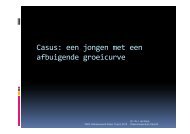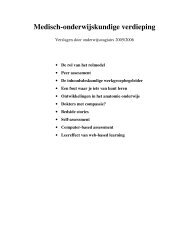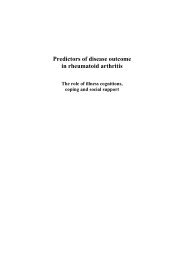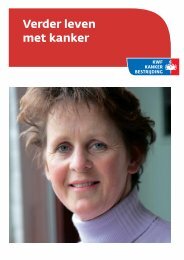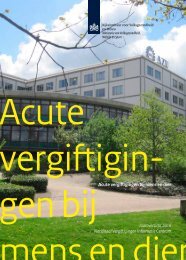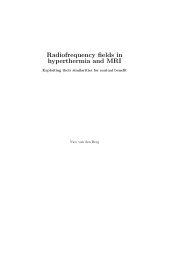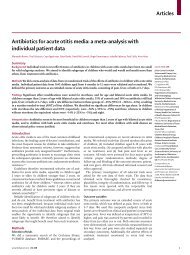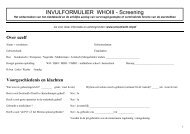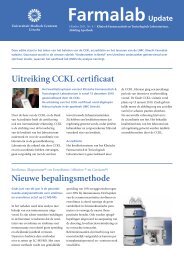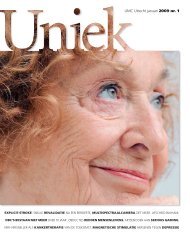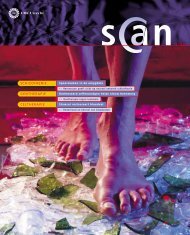Rudolf Magnus Bulletin 21 March 2006 - UMC Utrecht
Rudolf Magnus Bulletin 21 March 2006 - UMC Utrecht
Rudolf Magnus Bulletin 21 March 2006 - UMC Utrecht
You also want an ePaper? Increase the reach of your titles
YUMPU automatically turns print PDFs into web optimized ePapers that Google loves.
<strong>Rudolf</strong> <strong>Magnus</strong> <strong>Bulletin</strong> <strong>21</strong><br />
<strong>March</strong> <strong>2006</strong><br />
interview<br />
PINE assessed pain in herpes zoster<br />
Chronic pain syndrome is a common complication of<br />
herpes zoster. Bart Van Wijck, Wim Opstelten and<br />
colleagues performed the first ever randomised, controlled<br />
trial to establish the effect of a single injection<br />
in the spine with both anti-inflammatory and painkilling<br />
drugs. They demonstrated, in a Lancet article,<br />
that these injections, although common practice, had<br />
only limited effect and were ineffective for long-term<br />
treatment of chronic pain after herpes zoster.<br />
Postherpetic neuralgia is a neuropathic pain syndrome<br />
associated with the reactivation of varicella zoster virus<br />
(herpes zoster), which resides in latent form in sensory<br />
trigeminal and dorsal root ganglia in the spine after primary<br />
infection as varicella (chickenpox). This pain syndrome is<br />
the most frequent complication of herpes zoster, which<br />
occurs in 9–34% of varicella infections. Postherpetic<br />
neuralgia often negatively affects quality of life, because<br />
many patients develop severe physical, occupational, and<br />
social disabilities as a consequence of their chronic pain.<br />
Once the syndrome has developed, the effect of treatment<br />
is disappointing. Although the effectiveness of a varicella<br />
zoster vaccine on prevention of zoster-related morbidity is<br />
promising, postherpetic neuralgia will remain a serious<br />
problem for many years. Antiviral therapy can shorten the<br />
duration of zoster-associated pain, but many patients with<br />
herpes zoster develop postherpetic neuralgia despite such<br />
treatment. Van Wijck: “As herpes zoster goes together with<br />
local inflammation of the dorsal root ganglion, and this<br />
inflammation is considered to be an important causative<br />
factor for postherpetic neuralgia, interventions can be<br />
aimed at reducing this inflammation. Although epidural<br />
injections have been used for decades both to treat zosterassociated<br />
pain and to prevent postherpetic neuralgia, the<br />
effectiveness of this treatment was not previously assessed<br />
in a randomised clinical trial.”<br />
The PINE study (Prevention by epidural Injection of<br />
postherpetic Neuralgia in the Elderly), an open randomised<br />
multicentre trial, was designed to quantify the effectiveness<br />
of a single epidural injection of 80 mg methylprednisolone<br />
and 10 mg bupivacaine in addition to<br />
standard treatment during the acute phase of herpes<br />
zoster in preventing postherpetic neuralgia. A total of 598<br />
patients was included older than 50 years with acute<br />
herpes zoster (rash
PhD theses<br />
<strong>2006</strong>-4<br />
<strong>March</strong> 8, <strong>2006</strong><br />
Frank R. Van Genderen<br />
Functional limitations in severe haemophilia<br />
P.J.M. Helders, H.M. Van den Berg,<br />
N.L.U. Van Meeteren<br />
supervisors<br />
<strong>2006</strong>-5<br />
Predicting complications in SAH<br />
<strong>March</strong> 9, <strong>2006</strong><br />
Wouter J. Schuiling<br />
Extracerebral organ dysfunction and sleep disorders<br />
in subarachnoid haemorrhage<br />
G.J.E. Rinkel, A. Algra, A.W. De Weerd,<br />
P.J.W. Dennesen<br />
supervisors<br />
Cardiac and pulmonary complications are common in<br />
subarachnoid haemorrhage (SAH), but also other<br />
extracerebral complications are frequently observed.<br />
Wouter Schuiling found that these complications can<br />
be predicted and probably treated better if attention is<br />
given to cardiac troponin I. Incorporating signs of<br />
extracerebral organ dysfunction in grading scales can<br />
help in prognosticating outcome. Attention for sleep<br />
disorders can further improve long-term outcome.<br />
Schuiling performed an epidemiological study on a cohort<br />
of 172 patients with aneurysmal SAH, who were treated<br />
according to standard intensive care guidelines for at least<br />
2 weeks. Schuiling about the results; “ECG abnormalities<br />
have only limited value in predicting poor outcome. Cardiac<br />
troponin I appeared to be a powerful predictor for the<br />
occurrence of pulmonary and cardiac complications.<br />
Pulmonary oedema and depressed cardiac contractile<br />
function were frequently observed in the first 5 days after<br />
SAH. A depressed cardiac contractile function in at least<br />
one day in the first 5 days after SAH onset was more<br />
prevalent in patients with an elevated cardiac troponin I.<br />
Single transpulmonary thermodilution technique appeared<br />
to be a promising tool for monitoring SAH patients<br />
especially with elevated cardiac troponin I on admission.<br />
The simplified acute physiology score (SAPS II) is a useful<br />
and reliable prognosticator in SAH patients. This score<br />
may in some circumstances provide more information than<br />
specific SAH rating scales in predicting poor outcome or<br />
the occurrence of delayed cerebral ischemia. In patients<br />
with a good outcome according to the Rankin scale 50%<br />
complained of tiredness. In these patients disorders of<br />
sleep and wake occurred in one-third. Patients with severe<br />
sleep disturbances often have a considerably reduced<br />
quality of life.<br />
Schuiling summarizes: “Extracerebral organ dysfunction is<br />
frequently seen after SAH. Grading scales incorporating<br />
signs of extracerebral organ dysfunction should be used<br />
more frequently by neurologists and neurosurgeons<br />
treating SAH patients. Cardiac troponin I can be used as<br />
marker to identify patients who are at risk of developing<br />
cardiopulmonary complications and could benefit from<br />
early invasive hemodynamic monitoring. Additional studies<br />
using single transpulmonary thermodilution are required to<br />
study the effects of cardiac and pulmonary estimates on<br />
delayed cerebral ischemia and outcome in SAH patients.<br />
Also studies with extended follow-up are required to<br />
evaluate whether a therapeutic strategy taking into account<br />
cardiac index, cardiac contractile function and<br />
extravascular lung water can improve supportive therapy<br />
and outcome. The improvement of long-term outcome<br />
should focus on attention for sleep disorders in patients<br />
complaining of daytime fatigue, restless or non-restorative<br />
sleep, snoring, and restless legs syndrome.”<br />
Wouter Schuiling (April 4, 1968, Amsterdam). Secondary<br />
education (Rijksscholengemeenschap, Amersfoort), 1986;<br />
Medicine (Groningen University), MD 1995; registered as<br />
neurologist, 2004 (Medisch Centrum Haaglanden, Den Haag).<br />
During his residency in Neurology he started the research as<br />
described in this thesis. He presently works as neurologist in the<br />
Medisch Centrum Leeuwarden.<br />
<strong>2006</strong>-6<br />
Walking after stroke<br />
<strong>March</strong> 14, <strong>2006</strong><br />
Boudewijn J. Kollen<br />
Recovery of gait after stroke<br />
E. Lindeman, G. Kwakkel<br />
supervisors<br />
Boudewijn Kollen addressed the long-term recovery of<br />
hemiplegic gait in severely affected stroke patients, by<br />
clinimetric and prognostic, and by therapeutic intervenetion<br />
studies. He was able to identify the determinants<br />
of late outcome and he demonstrated that the<br />
long-term effects of intensity of stroke rehabilitation,<br />
implemented during the initial 20 post-stroke weeks,<br />
are maintained for up to one year.<br />
With the institutionalisation of stroke services across health<br />
care facilities a reduction in mortality rates, length of<br />
inpatient stay and improved independence in activities of<br />
daily living have been reported. Recently developed<br />
treatment strategies, that incorporate compensation<br />
strategies with a strong emphasis on functional training,<br />
may hold the key to optimal stroke rehabilitation. Kollen<br />
describes the long-term recovery of hemiplegic gait in<br />
web http://www.rudolfmagnus.nl coordination j.dekker@med.uu.nl, phone +31 30 253 8110
severely affected stroke patients. Based on the application<br />
of a repeated measurement research design, data were<br />
obtained within the first post-stroke year period. This<br />
information subsequently enabled the identification of timerelated<br />
changes and was used by Kollen to address the<br />
following main questions: Are intensive stroke rehabilitation<br />
programmes, implemented within the early and<br />
subacute post-stroke phases, worthwhile in terms of longterm<br />
functional gains and can this long-term recovery be<br />
estimated early after stroke onset for better individualised<br />
reliable therapeutic goal setting and discharge planning?<br />
For this purpose, Kollen studied early and late recovery<br />
patterns as functional recovery after stroke tends to be<br />
non-linear and time-dependent. Subsequently, this<br />
information was used in the interpretation of some of the<br />
mechanisms involved in the long-term recovery of<br />
hemiplegic gait and the impact of intensity of therapeutic<br />
interventions on this recovery. The main findings of<br />
Kollen’s clinimetric and prognostic studies indicate<br />
predictive relationships between early determinants and<br />
late outcome and the relevance of measuring frequently<br />
and longitudinally in order to take into consideration the<br />
non-linear time-dependent relationship of covariates with<br />
recovery of gait after stroke. In the subsequent therapeutic<br />
intervention studies Kollen demonstrated that the long-term<br />
effects of intensity of stroke rehabilitation, implemented<br />
during the initial 20 post-stroke weeks, are maintained for<br />
up to one year.<br />
Boudewijn Kollen (February 26, 1956). Physiotherapy<br />
(Amsterdam), 1976; Epidemiology (Vrije Universiteit,<br />
Amsterdam), 2004. Physiotherapist at the Valerius Clinic,<br />
Amsterdam (1976-83), St. Michael’s Hospital, Toronto, Canada<br />
(1983-86), Baycrest Centre for Geriatric Care, Toronto, Canada<br />
(1986-89), and the Isala Clinics, Zwolle. Presently he works at<br />
the Research Bureau, Isala Clinics, Zwolle.<br />
<strong>2006</strong>-7<br />
Do piglets suffer when the sow is stressed?<br />
<strong>March</strong> 30, <strong>2006</strong><br />
Godelieve Kranendonk<br />
Prenatal stress in pigs<br />
M.A.M. Taverne, V.M. Wiegant, E.D. Ekkel,<br />
E.J.H. Mulder<br />
supervisors<br />
Stress in pregnant sows can affect both the wellbeing<br />
and health of the sows and her piglets. Godelieve<br />
Kranendonk applied hormonal and social stress to<br />
pregnant sows and studied the behaviour and stress<br />
physiology of the piglets. Stress during gestation<br />
appeared to affect both performance and behaviour of<br />
the piglets.<br />
Prenatal stress may be a relevant issue for husbandry<br />
pigs, since pregnant sows likely experience stressful<br />
situations during gestation, for instance as a consequence<br />
of housing and management practice. This may result in<br />
prenatal stress for their piglets. Kranendonk studied<br />
whether body weight, behaviour, or HPA-axis activity of<br />
piglets were affected when their mothers are exposed to<br />
stressors during gestation. In a first series of experiments<br />
Kranendonk exposed pregnant sows to the stress<br />
hormone cortisol and studied the performance of their<br />
piglets. She demonstrated that piglets can indeed be<br />
affected by elevated maternal cortisol concentrations<br />
Courtesy of Godelieve Kranendonk<br />
during gestation in their body weight, growth, survival,<br />
behaviour, and adrenocortical response to ACTH. Further,<br />
female piglets have an enhanced fever response when<br />
challenged by lipopolysaccharide. Some of these effects<br />
(e.g., response to challenges and behaviour) depended on<br />
the period of gestation during which maternal cortisol<br />
concentrations were elevated, or on the sex of the<br />
offspring (e.g., with respect to behaviour).<br />
In another series of experiments Kranendonk applied mild<br />
stress to pregnant sows in the form of social challenge.<br />
Social challenges did not elicit elevated cortisol concentrations<br />
in the pregnant sows. Regular mixing of pregnant<br />
sows, which produced a mild form of social stress during<br />
the last month of gestation, did not affect piglet characteristics,<br />
which can possibly be explained by this lack of<br />
elevated maternal cortisol concentrations during gestation.<br />
The social rank of sows (measured as winning of more<br />
agonistic interactions than they lose) during gestation, did<br />
affect piglet performance (in particular body weight at<br />
weaning and lean meat percentage at slaughter) and<br />
behaviour in a new environment. Furthermore, effects of<br />
maternal treatment on piglet characteristics were studied<br />
until eight weeks of age (behaviour and adrenocortical<br />
aspects) or until slaughter. Kranendonk: “It would be<br />
relevant to study whether piglets face long-term<br />
consequences of maternal treatments as applied in the<br />
experiments. This would be especially important for gilts<br />
that are kept for breeding.”<br />
Kranendonk explains the broader perspective of her<br />
results: “Our studies provide data that indicate that<br />
elevated maternal cortisol concentrations and social rank<br />
of pregnant sows affect performance and behaviour of<br />
their offspring. Whether these piglets are better off or<br />
perform less optimal in daily stressful situations remains to<br />
be elucidated. Nevertheless, stress during gestation does<br />
impair welfare of the pregnant sow herself. Hence, pig<br />
farmers should minimise stress exposure for pregnant<br />
sows. The number of agonistic interactions of pregnant<br />
sows around the feeding station in group housing should<br />
be reduced, e.g., by use of a protected feeding area or<br />
distraction materials.”<br />
Godelieve Kranendonk (January 31, 1977, Rotterdam)<br />
Secondary education (Christelijke Scholengemeenschap<br />
Walcheren, Middelburg), 1995; Biology (Catholic University<br />
Nijmegen and <strong>Utrecht</strong> University), 2001. From 2001-2005 she<br />
worked on the project as described in her thesis. Presently she<br />
works at the Department of Farm Animal Health, Veterinary<br />
Faculty, University <strong>Utrecht</strong>.<br />
secretariat Universiteitsweg 100, 3584 CG <strong>Utrecht</strong>, The Netherlands, m.vandenadort@med.uu.nl, phone +31 30 253 8847
news<br />
Collaboration Institute of Psychiatry is funded<br />
The <strong>UMC</strong> <strong>Utrecht</strong> stimulates the internationalisation of the<br />
research within its perimeter. The major research institutes<br />
of the <strong>UMC</strong> <strong>Utrecht</strong> were invited to apply for a competitive<br />
grant of € 200,000. The Institute of Psychiatry, London,<br />
U.K., was identified as partner of our Institute for a<br />
strategic alliance. The Institute of Psychiatry is a large<br />
neuroscience institute of undisputed reputation, which is<br />
active on overlapping, and complementary, fields of<br />
neuroscience research. In the past years meetings were<br />
held at the Institute’s highest level to explore the possibilities<br />
for such an alliance. It was agreed that both the<br />
<strong>Rudolf</strong> <strong>Magnus</strong> Institute and the Institute of Psychiatry will<br />
facilitate close contacts between their staff members in<br />
order to actively encourage collaboration between both<br />
institutes. On January 24, <strong>2006</strong>, the <strong>UMC</strong> <strong>Utrecht</strong><br />
committee deciding on this issue announced that our<br />
Institute was awarded with this grant to stimulate contact<br />
and collaboration with the Institute of Psychiatry. With<br />
some additional financial support of both institutes, the<br />
programme (<strong>2006</strong>-2009) will support the collaboration by<br />
travel grants for staff, organising workshops, and by<br />
initiating a visiting professor programme. A list of planned<br />
workshops and formal information how to apply for support<br />
will be released soon.<br />
Olaf Cremer wins Pfizer NVIC Award<br />
Olaf Cremer, anaesthesiologist, has won the yearly award<br />
of the Netherlands Society for Intensive Care (NVIC); this<br />
year sponsored by Pfizer. The award is presented for the<br />
best PhD thesis in the Netherlands in the field of intensive<br />
care-related research. Cremer won the award with his<br />
thesis entitled, ‘Goal-directed intensive care of traumatic<br />
brain injury: pathophysiological and clinical studies’<br />
(October 5, 2005, See <strong>Rudolf</strong> <strong>Magnus</strong> <strong>Bulletin</strong> 16). The<br />
award consists of a sum of money, which is to be used in<br />
part to re-print (150 copies) Cremer’s thesis for distribution<br />
among all intensive care units in the Netherlands.<br />
Saskia Van der Hel Lecturer of the Year<br />
Saskia Van der Hel, assistant professor at the Department<br />
of Pharmacology and Anatomy, was award with the title<br />
‘Lecturer of the Year’ by the students of the <strong>UMC</strong> <strong>Utrecht</strong>.<br />
Van der Hel received this much envied title for her<br />
enthusiasm and her great ability to motivate students.<br />
Marike Broekman wins Talma Eykman Award<br />
The Talma Eyman Award is presented to excellent<br />
undergraduate students at the <strong>UMC</strong> <strong>Utrecht</strong> who have<br />
distinguished themselves during their research internship.<br />
On February 9, <strong>2006</strong>, this year’s award for medical<br />
students was presented to Marike Broekman (supervisor<br />
Peter Burbach, Dept Pharmacology and Anatomy) for her<br />
work entitled, “Adeno-associated virus vectors serotyped<br />
with AAV8 capsid are more efficient than AAV-1 or -2<br />
serotypes for widespread gene delivery to the neonatal<br />
mouse brain”. The work was performed at the Departments<br />
of Neurology and Neuroscience, Mass. General<br />
Hospital and Harvard Medical School, Charlestown, MA,<br />
USA.<br />
agenda<br />
<strong>March</strong> 1, <strong>Rudolf</strong> <strong>Magnus</strong> Seminar<br />
Ruud F.G.Toonen (CNCR, Vrije Universiteit, Amsterdam)<br />
‘Molecular Mechanisms of secretory vesicle targeting<br />
and docking’<br />
Stratenum Building, <strong>UMC</strong> <strong>Utrecht</strong>, Room 4.208, 16:00-17:00<br />
Contact j.pasterkamp@med.uu.nl<br />
<strong>March</strong> 3, Helmholtz Lecture<br />
David F. Clayton (University of Illinois, USA)<br />
‘Neurogenomics of bird song memory’<br />
‘Rode zaal’, Ruppert Building, Leuvenlaan 19, <strong>Utrecht</strong>, 16:00-17:00<br />
Contact, v.maassen@fss.uu.nll<br />
<strong>March</strong> 3, <strong>Rudolf</strong> <strong>Magnus</strong> Seminar<br />
Rustam Al-Shahi (University of Edinburgh, UK)<br />
‘'Epidemiology, prognosis and treatment of brain<br />
arteriovenous malformations’<br />
Lecture room, C3West, <strong>UMC</strong> <strong>Utrecht</strong>, 12:45-13:30<br />
Contact, J.vanBeijnum@umcutrecht.nl<br />
<strong>March</strong> 9, Winter Conference, Dutch Society of<br />
Psychophysiology<br />
‘Boothzaal’, University Library, Heidelberglaan 3, <strong>Utrecht</strong>, 10:00-<br />
17:00. Programme, www.rudolfmagnus.nl<br />
Contact, k.b.e.bocker@pharm.uu.nl<br />
<strong>March</strong> 17, Inaugural address Carl Moons<br />
Professor of Clinical Epidemiology.<br />
Academy Building, Domplein 29, <strong>Utrecht</strong>, 16:15<br />
<strong>March</strong> 31, Symp. on Pharmacotherapy for ADHD<br />
See for programme our website, http://www.rudolfmagnus.nl<br />
Contact, j.l.kenemans@fss.uu.nl<br />
April 19-27, Course on Neuropsychopharmacology<br />
Venue, partly in Amsterdam, Weesp, and <strong>Utrecht</strong>. Programme,<br />
http://www.rudolfmagnus.nl. Registration, eam.borghols@vumc.nl<br />
May 4-5, Meeting of the Association of European<br />
Psychiatrists - Neuroimaging Section<br />
‘Neuroimaging Change over Time in Psychiatry’<br />
Academy Building, Domplein 29, <strong>Utrecht</strong><br />
Programme and registration, http://www.rudolfmagnus.nl<br />
August 28-29, <strong>Rudolf</strong> <strong>Magnus</strong>-Helmholtz<br />
Summerschool<br />
Conference Centre Ottone, Kromme Nieuwegracht 62, <strong>Utrecht</strong>.<br />
Programme to be announced, check our website for updates,<br />
http://www.rudolfmagnus.nl<br />
September 8-9, Brain Days<br />
A two-days meeting with international experts on the<br />
theme, ‘Brain plasticity in children’.<br />
<strong>UMC</strong> <strong>Utrecht</strong>. Programme to be announced, check our website for<br />
updates, http://www.rudolfmagnus.nl<br />
November 8, <strong>Rudolf</strong> <strong>Magnus</strong> Symposium<br />
Including the <strong>Rudolf</strong> <strong>Magnus</strong> Lecture <strong>2006</strong> by<br />
Frans De Waal (Emory Univ. Atlanta, USA) and the<br />
announcement of the winner of the <strong>Rudolf</strong> <strong>Magnus</strong><br />
Research Award <strong>2006</strong>.<br />
<strong>UMC</strong> <strong>Utrecht</strong>, 13:30-17:15. Programme to be announced, check<br />
our website for updates, http://www.rudolfmagnus.nl<br />
Contact, m.vandenadort@med.uu.nl<br />
November 8, <strong>Rudolf</strong> <strong>Magnus</strong> Evening<br />
A unique mixture of social and scientific events is<br />
organised following the <strong>Rudolf</strong> <strong>Magnus</strong> Symposium.<br />
<strong>UMC</strong> <strong>Utrecht</strong>, 18:00-<strong>21</strong>:30, programme will include diner, details to<br />
be announced. The evening programme is only (and freely)<br />
accessible for all members of the <strong>Rudolf</strong> <strong>Magnus</strong> Institute.<br />
Registration is required, contact, m.vandenadort@med.uu.nl<br />
© <strong>2006</strong> <strong>Rudolf</strong> <strong>Magnus</strong> Institute editor Jan Dekker photography Chris Timmers print Zuidam&Uithof ISSN 1574-3071



